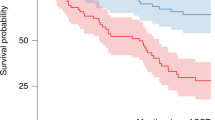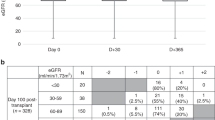Abstract
Autologous stem cell transplant (ASCT) is a feasible treatment option for multiple myeloma (MM) patients with renal insufficiency; however, these patients tend to experience higher rates of drug toxicity and transplant-related mortality (TRM) during ASCT. Recent adoption of bortezomib-based induction regimens and dose reduction of melphalan during conditioning may improve outcomes in this population. In this single center retrospective study, we compared the toxicity and survival outcomes of 96 MM patients with renal insufficiency undergoing ASCT between two eras: 1998–2007 and 2008–2016. The proportion of dialysis dependent patients was similar in both groups (49 and 45%). We found no TRM in those transplanted more recently as compared with 13% in the older era of ASCT. There were significantly more high grade (grades 3–4) toxicities in the older era of ASCT including high grade electrolyte abnormalities, mucositis, delirium, and bleeding. Patients transplanted more recently had significantly higher overall response rate (ORR) as well as deeper responses to ASCT (≥VGPR in 79% vs 39%). Progression-free survival (PFS) was prolonged by 26 months in the more recent era compared with the older era. Overall, improvements in treatment regimens have resulted in reduced TRM and toxicities for patients with renal insufficiency undergoing ASCT.
This is a preview of subscription content, access via your institution
Access options
Subscribe to this journal
Receive 12 print issues and online access
$259.00 per year
only $21.58 per issue
Buy this article
- Purchase on Springer Link
- Instant access to full article PDF
Prices may be subject to local taxes which are calculated during checkout


Similar content being viewed by others
References
Knudsen L, Nielsen B. Autologous stem cell transplantation in multiple myeloma: outcome in patients with renal failure. Eur J Haematol. 2005;75:27–33.
Gaballa MR, Laubach JP, Schlossman RL, Redman K, Noonan K, Munshi N, et al. Management of myeloma-associated renal dysfunction in the era of novel therapies. Expert Rev Hematol. 2013;5:51–68.
Badros A, Barlogie B, Siegel E, Roberts J, Langmaid C, Zangari M, et al. Results of autologous stem cell transplant in multiple myeloma patients with renal failure. Br J Haematol. 2001;114:822–9.
El Fakih R, Fox P, Popat U, Nieto Y, Shah N, Parmar S, et al. Autologous hematopoietic stem cell transplantation in dialysis-dependent myeloma patients. Clin Lymphoma Myeloma Leuk. 2015;15:472–6.
Parikh GC, Amjad AI, Saliba RM, Kazmi SMA, Kahn ZU, Lahoti A, et al. Autologous hematopoietic stem cell transplantation may reverse renal failure in patients with multiple myeloma. Biol Blood Marrow Transpl. 2009;15:812–6.
St Bernard R, Chodirker L, Masih-Khan E, Jiang H, Franke N, Kukreti V, et al. Efficacy, toxicity and mortality of autologous SCT in multiple myeloma patients with dialysis-dependent renal failure. Bone Marrow Transpl. 2015;50:95–99.
Areethamsirikul N, Masih-Khan E, Chu C-M, Jimenez-Zepeda V, Reece DE, Trudel S, et al. CyBorD induction therapy in clinical practice. Bone Marrow Transpl. 2015;50:375–9.
Breitkreutz I, Heiss C, Perne A, Beimler J, Jager D, Egerer G, et al. Bortezomib improves outcome after SCT in multiple myeloma patients with end-stage renal failure. Bone Marrow Transpl. 2014;49:1371–5.
San Miguel JF, Schlag R, Khuageva NK, Dimopoulos MA, Shpilberg O, Kropff M, et al. Bortezomib plus melphalan and prednisone for initial treatment of multiple myeloma. N Engl J Med. 2008;359:906–17.
Dimopoulos MA, Roussou M, Gkotzamanidou M, Nikitas E, Psimenou E, Mparmparoussi D, et al. The role of novel agents on the reversibility of renal impairment in newly diagnosed symptomatic patients with multiple myeloma. Leukemia. 2013;27:423–9.
Chanan-Khan AA, San Miguel JF, Jagannath S, Ludwig H, Dimopoulos MA. Novel therapeutic agents for the management of patients with multiple myeloma and renal impairment. Clin Cancer Res. 2012;18:2145–63.
Scheid C, Sonneveld P, Schmidt-Wolf IGH, van der Holt B, el Jarari L, Bertsch U, et al. Bortezomib before and after autologous stem cell transplantation overcomes the negative prognostic impact of renal impairment in newly diagnosed multiple myeloma: a subgroup analysis from the HOVON-65/GMMG-HD4 trial. Haematologica. 2014;99:148–54.
McCarthy K, Hofmeister CC, Hurd DD, Hassoun H, Richardson PG, Giralt S, et al. Lenalidomide after stem-cell transplantation for multiple myeloma. N Engl J Med. 2012;366:1770–81.
McCarthy PL, Holstein SA, Petrucci MT, Richardson PG, Hulin C, Tosi P, et al. Lenalidomide maintenance after autologous stem-cell transplantation in newly diagnosed multiple myeloma: a meta-analysis. J Clin Oncol. 2017;35:3279–89.
Tomblyn M, Chiller T, Einsele H, Gress R, Sepkowitz K, Storek J, et al. Guidelines for preventing infectious complications among hematopoietic cell transplantation recipients: a global perspective. Biol Blood Marrow Transpl. 2009;15:1143–238.
Terpos E, Morgan G, Dimopoulos MA, Drake MT, Lentzsch S, Raje N, et al. International myeloma working group recommendations for the treatment of multiple myeloma-related bone disease. J Clin Oncol. 2013;31:2347–57.
Cockcroft DW, Gault MH. Prediction of creatinine clearance from serum creatinine. Nephron. 1976;16:31–41.
Lee CK, Zangari M, Barlogie B, Fassas A, van Rhee F, Thertulien R, et al. Dialysis-dependent renal failure in patients with myeloma can be reversed by high-dose myeloablative therapy and autotransplant. Bone Marrow Transpl. 2004;33:823–8.
Katragadda L, McCullough LM, Dai Y, Hsu J, Byrne M, Hiemenz J, et al. Effect of melphalan 140mg/m 2 vs 200mg/m 2 on toxicities and outcomes in multiple myeloma patients undergoing single autologous stem cell transplantation-a single center experience. Clin Transpl. 2016;30:894–900.
Raab MS, Breitkreutz I, Hundemer M, Benner A, Klaus J, Hegenbart U, et al. The outcome of autologous stem cell transplantation in patients with plasma cell disorders and dialysis-dependent renal failure. Haematol Hematol J. 2006;91:1555–8.
Grazziutti ML, Dong L, Miceli MH, Krishna SG, Kiwan E, Syed N, et al. Oral mucositis in myeloma patients undergoing melphalan-based autologous stem cell transplantation: Incidence, risk factors and a severity predictive model. Bone Marrow Transpl. 2006;38:501–6.
Tricot G, Aberts DS, Johnson C, Roe DJ, Dorr RT, Bracy D, et al. Safety of autotransplants with high dose melphalan in renal failure: a pharmacokinetic and toxicity study. Clin Cancer Res. 1996;2:947–52.
Dimopoulos MA, Roussou M, Gavriatopoulou M, Psimenou E, Eleutherakis-Papaiakovou E, Migkou M, et al. Bortezomib-based triplets are associated with a high probability of dialysis independence and rapid renal recovery in newly diagnosed myeloma patients with severe renal failure or those requiring dialysis. Am J Hematol. 2016;91:499–502.
Mian I, Milton DR, Shah N, Nieto Y, Popta U, Kebriaei P, et al. Prolonged survival with a longer duration of maintenance lenalidomide after autologous hematopoietic stem cell transplantation for multiple myeloma. Cancer. 2016;122:3831–7.
Author information
Authors and Affiliations
Corresponding author
Ethics declarations
Conflict of interest
CIC, ST, DR, RT, AP, and VK have received research funding and honoraria from Janssen and Celgene. The other authors declare that they have no conflict of interest.
Additional information
Publisher’s note Springer Nature remains neutral with regard to jurisdictional claims in published maps and institutional affiliations.
Rights and permissions
About this article
Cite this article
Li, A.Y., Atenafu, E.G., Bernard, R.S. et al. Toxicity and survival outcomes of autologous stem cell transplant in multiple myeloma patients with renal insufficiency: an institutional comparison between two eras. Bone Marrow Transplant 55, 578–585 (2020). https://doi.org/10.1038/s41409-019-0697-8
Received:
Revised:
Accepted:
Published:
Issue Date:
DOI: https://doi.org/10.1038/s41409-019-0697-8
This article is cited by
-
Prognostic factors in 448 newly diagnosed multiple myeloma receiving bortezomib-based induction: impact of ASCT, transplant refusal and high-risk MM
Bone Marrow Transplantation (2024)
-
Autologous stem cell transplantation in multiple myeloma patients with renal impairment
Annals of Hematology (2023)
-
Safety and efficacy of chimeric antigen receptor T-cell therapy in relapsed/refractory multiple myeloma with renal impairment
Bone Marrow Transplantation (2020)



